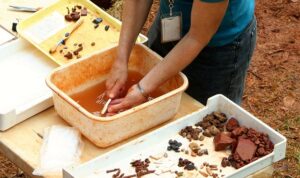What a 2 Million Year Old Spine Can Tell Us
What was the earth like 2 million years ago? Humans didn’t exist but what about our early ancestors? A newly discovered spine is shedding a little light on our early ancestors.
Discovery of Spine Fossils
A nearly complete lumbar portion of a spine was discovered in our in architectural dig in South Africa. The vertebrae are believed to be a female from the species known as Australopithecus sediba. The 2nd, 3rd, 4th, and 5th vertebrae were all discovered, allowing scientists to gain a better understanding of how this species moved.
 This species was first identified just over ten years ago when two remains were found in a cave in South Africa. The remains, an adult female and juvenile male, had traits similar to both primitive and more advanced species on the evolutionary spectrum. Analysis has brought some debate among scientists about the new species and what it can tell us about our origins.
This species was first identified just over ten years ago when two remains were found in a cave in South Africa. The remains, an adult female and juvenile male, had traits similar to both primitive and more advanced species on the evolutionary spectrum. Analysis has brought some debate among scientists about the new species and what it can tell us about our origins.
The new partial spine that has been discovered may be able to shed some light on the subject.
Curvature of the Spine
If you read about the anatomy of the human spine, you will see that our spine has three curves. In the neck it curves toward the front of the body, in the middle back the spine curves toward the back of the body, and in the lower back (lumbar region) it again curves toward the front of the body. This natural curvature is known as lordosis.
Read about conditions characterized by abnormal curvature of the spine.
Fossil Spine Curvature
Because almost the complete lower (lumbar) portion of spine has beenfound, scientists are able to see and measure the curvature of this species’ spine. Scientists were surprised to discover that this species had a lower back curvature similar to that of humans.
Vertebrae Shape
The shape of each vertebra also provides clues to scientists about this species’ movements.
Going back to the anatomy of the human spine, each individual bone of the spine, called vertebra, has a distinct shape. The vertebrae may all differ in size but each has a circular portion called the body and multiple portions that protrude from the body, called facets. The body of the vertebrae encircles the spinal cord and protects it. The facets allow for articulation, or movement, as they meet up with adjacent vertebrae to form joints.
Shape of the Fossil Vertebrae
Since several adjacent vertebrae were discovered, scientists are able to see how the joints of this species spine work. The shape of the facets and how they align with adjacent vertebrae also give the scientists a better understanding of their bodies’ weight distribution. Based on their analysis, scientists suspect that Australopithecus sediba possibly walked on two legs as humans do. Interestingly, they also believe this species was able to climb trees and swing from branches like apes.
Where Australopithecus sediba fits on the evolutionary map is still unclear. But this species helps provide clues into our possible ancestors’ behaviors
Mammals spines are an important part of their body. Not do they protect precious nerves, but they provide support and structure for our bodies. As such, identifying just a portion of an ancient species spine has provided a huge amount of information about how that species stood and moved.
References:
